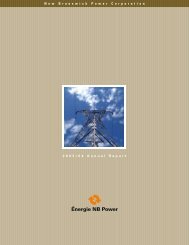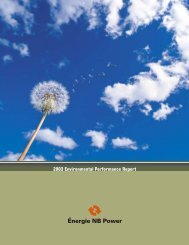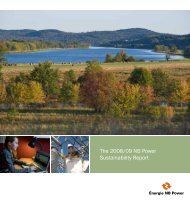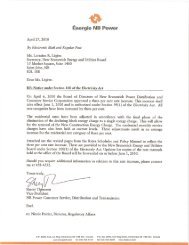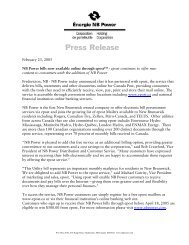Environmental Impact Assessment(EIA) Registration for the ...
Environmental Impact Assessment(EIA) Registration for the ...
Environmental Impact Assessment(EIA) Registration for the ...
Create successful ePaper yourself
Turn your PDF publications into a flip-book with our unique Google optimized e-Paper software.
REVISED PROJECT DESCRIPTION AND ENVIRONMENTAL IMPACT ASSESSMENT (<strong>EIA</strong>) REGISTRATION<br />
FOR THE NEPISIGUIT FALLS GENERATING STATION MODIFICATION AND REHABILITATION PROJECT<br />
The river reach impounded by <strong>the</strong> NFGS (i.e., <strong>the</strong> headpond) is approximately 4 km long and<br />
90 m to 160 m wide. The headpond has a surface area, at full supply level, of approximately<br />
56 ha. Below <strong>the</strong> falls, a river width of 70 m to 110 m is common, although narrower sections of<br />
25 m to 50 m width are found in areas where river grades are steeper. River widths of 70 m to<br />
100 m are also common in <strong>the</strong> reach above <strong>the</strong> headpond. The river is <strong>for</strong> <strong>the</strong> most part<br />
bedrock controlled, and quite shallow, except near <strong>the</strong> generating station where <strong>the</strong> <strong>for</strong>ebay has<br />
been artificially deepened in order to provide a small amount of water storage, as well as<br />
hydraulic head <strong>for</strong> power generation. The spillway dam has a sill at approximately 96.0 m<br />
(315 ft) elevation in relation to <strong>the</strong> NFGS site datum.<br />
Normal operating range of <strong>the</strong> headpond during <strong>the</strong> summer months is approximately 104.1 m<br />
to 104.2 m (341.5 ft to 342 ft), with <strong>the</strong> minimum operating level of 103.9 m (341 ft) and a<br />
maximum headpond elevation of approximately 105.5 m (346 ft)—with all measurements in<br />
relation to <strong>the</strong> NFGS site datum. The headpond elevation with <strong>the</strong> main rubber dam deflated<br />
would be approximately 100.9 m (331 ft), which would be similar to <strong>the</strong> natural <strong>the</strong> run-of-<strong>the</strong>river<br />
elevation.<br />
This indicates a normal (operating) water depth of at approximately 3.4 m (11 ft) at <strong>the</strong> face of<br />
<strong>the</strong> spillway dam. Assuming that <strong>the</strong> river bed in some areas may be as much as 2 m below <strong>the</strong><br />
sill at <strong>the</strong> spillway, <strong>the</strong> normal water depth in <strong>the</strong> deepest parts of <strong>the</strong> headpond is not likely to<br />
be greater than about 6 m.<br />
In 1969, a spill of waste from <strong>the</strong> <strong>for</strong>mer Bathurst Iron Mine into <strong>the</strong> Nepisiguit River just<br />
upstream from <strong>the</strong> NFGS resulted in a large kill of juvenile salmon in <strong>the</strong> lower portion of <strong>the</strong><br />
river. Salmon catches between 1970 and 1975 appear to have been substantially depressed;<br />
however, <strong>the</strong> river appears to have recovered by 1980 (based on data presented in Locke et<br />
al. 1997).<br />
Research of existing documentation, and consultation with DFO as well as local fisheries<br />
groups, was undertaken to confirm <strong>the</strong> fish community present in <strong>the</strong> Nepisiguit River. The<br />
Nepisiguit River is Atlantic salmon (Salmo salar) bearing downstream of <strong>the</strong> falls; however, <strong>the</strong><br />
falls present a natural barrier to fish passage and no anadromous species are found upstream<br />
of <strong>the</strong> falls or <strong>the</strong> NFGS. The species assemblage above <strong>the</strong> NFGS consists of brook trout<br />
(Salvelinus fontinalis), white sucker (Catostomus commersonii) and various o<strong>the</strong>r coarse fish<br />
species such as dace and minnow (R. Baker, pers. comm. 2010; DFO 2010; Scott and<br />
Crossman 1998). Additionally, American eel (Anguilla rostrata) are likely able to navigate <strong>the</strong><br />
dam and falls as elvers and are known to be upstream of <strong>the</strong> facilities (R. Baker, pers. comm.<br />
2010; DFO 2010; Scott and Crossman 1998). There is no known presence of smallmouth bass<br />
in this reservoir, unlike o<strong>the</strong>r larger reservoirs in <strong>the</strong> province (Hatch 2008; R. Baker, pers.<br />
comm. 2010).<br />
Brook trout are reported to overwinter in <strong>the</strong> headpond, but move upstream in May-June to<br />
occupy better habitat during <strong>the</strong> summer, and in preparation <strong>for</strong> spawning in <strong>the</strong> fall (R. Baker,<br />
pers. comm. 2010). There is a brook trout fishery in and upstream of <strong>the</strong> headpond during May-<br />
June 15, 2011 Page 49




